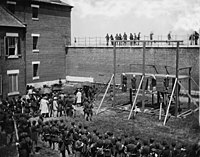Gallows


A gallows is a frame, typically wooden, used for execution by hanging.
A gallows can take several forms.
- the simplest form (as often used in the game "Hangman") resembles an inverted "L", with a single upright and a horizontal beam to which the rope noose would be attached.
- the horizontal crossbeam is supported at both ends.
- temporary gallows.
- the infamous Tyburn gallows was triangular in plan, with three uprights and three crossbeams, allowing up to 24 men and women to be executed simultaneously when all three sides were used.
Occasionally, an improvised gallows is used, usually by hanging the condemned from a tree or street light.
Types
Permanent
Gallows may be permanent to act as a deterrent and grim symbol of the power of high justice (the French word for gallows, potence, stems from the Latin word potentia, meaning "power"). Many old prints of European cities show such a permanent gallows erected on a prominent hill outside the walls, or more commonly near the castle or other seat of justice. In the modern era the gallows were often installed inside a prison; freestanding on a scaffold in the yard, erected at ground level over a pit, enclosed in a small shed of stone, brick or wood, built into the gallery of a prison wing (with beam in brackets on opposite walls), or in a purpose-built execution suite of rooms within the wing and close to the condemned cell.
Temporary
Gallows can also be temporary. In some cases, they were even moved to the location of the crime. In England, pirates were typically executed using a temporary gallows, at low tide in the Intertidal zone, then left for the sea to wash over them during three following high tides.[1]
Portable
If a crime took place inside, eg., a building, gallows may be erected—and the criminal hanged—at the front door. In some cases of multiple offenders it was not uncommon to erect multiple temporary gallows, with one noose per condemned criminal.
Horse and cart
Hanging people from early gallows sometimes involved fitting the noose (a.k.a the tater) around the person's neck while he or she was on a ladder or in a horse-drawn cart underneath. Removing the ladder or driving the cart away left the person dangling by the neck to slowly strangle. Later, a "scaffold" with a trap-door tended to be used, so victims dropped down and died quickly from a broken neck rather than through strangulation, especially if extra weights were fixed to their ankles.
During the era of public execution in London, England, a prominent gallows stood at Tyburn, now in the region of Connaught Square. Later executions occurred outside Newgate Gaol, now the Old Bailey.

See also
References
- ^ Konstam, Angus (1998). Pirates:1660-1730. Osprey Publishing. ISBN 1855327066.
External links
- BBC Article about British manufacturer.
- wikibooks:A Researcher's Guide to Local History Terminology: Local History terminology.
